Enhanced Renewable Energy Integration: A Comprehensive Framework for Grid Planning and Hybrid Power Plant Allocation
Abstract
1. Introduction
1.1. Literature Review
1.2. Contributions
1.3. Paper Organization
2. Proposed Joint Grid and HPPs Planning Model
2.1. Objective Function
2.2. Power Flow Constraints
2.3. N − 1 Security Constraints
2.4. ESS Constraints
2.5. RES Constraints
3. System Parameters and Assumptions
3.1. System Parameters
3.2. Renewable Energy Assumptions
4. Model Evaluation
4.1. Case Study 1: HPP Planning
4.2. Case Study 2: Independent Plant Planning
4.3. Hybrid vs. Independent Model Performance
4.4. Sensitivity Analyses
5. Discussion
6. Conclusions
- Cost savings are achieved by allocating a reduced amount of GCC through the utilization of shared infrastructure among RESs and ESSs.
- Integration of ESS into HPPs offers two benefits: alleviating the variability of operation costs imposed by uncertainty in EAPs of RESs and mitigating the undesirable curtailed energy of RESs.
- Curtailment cost is a key factor influencing ESS allocation and RES energy curtailment. The results show that as curtailment costs rise, curtailed energy decreases, facilitated by either increasing ESS capacity or reducing RES capacity.
- With N − 1 security constraints, ESS allocation increases, and injected energy by RESs decreases, while the curtailed energy by RES rises, which highlights the cost of maintaining system reliability.
- The planning model, by incorporating the HPPs, shows lower overall costs and greater renewable integration, requiring only a single permission and land allocation per node for grid connection.
- Incorporation of more granular temporal resolution and extreme-event modeling: The present study uses representative days to manage computational complexity. Future work can incorporate higher-resolution time series (including extreme weather events) to better capture short-term operational dynamics and resilience.
- Explicit modeling of market and regulatory mechanisms: The current framework optimizes purely from a techno-economic perspective. Including emissions trading schemes, capacity markets, and ancillary service markets would provide a more comprehensive assessment of investment strategies.
- Integration of emerging flexibility technologies: Technologies such as seasonal energy storage, power-to-X (e.g., hydrogen production), and advanced demand response could further enhance system flexibility and renewable absorption.
- Detailed reliability and resilience analysis: While N − 1 security is included, additional reliability criteria (e.g., N − 2 contingencies, probabilistic outage modeling, cyber-physical security) could be considered for more robust planning in critical infrastructure scenarios.
Author Contributions
Funding
Data Availability Statement
Conflicts of Interest
Nomenclature
| Indices & sets | |
| b | Index of system nodes |
| i | Index of thermal units |
| Index of system current/potential lines | |
| Set of systems nodes | |
| Set of thermal units | |
| Set of network current/potential lines | |
| Set of planning horizon | |
| t | Time index |
| T | Total time duration |
| x | Index of technology type (SF/WF/ESS/TL) |
| y | Index of planning years |
| Parameters | |
| Balancing cost of SF/WF | |
| Large positive constants | |
| Cost coefficient and max power of kth segment for ith TU in year y, time t | |
| WFs/SFs curtailment cost in year y, time t | |
| Maximum charge/discharge rate of ESSs | |
| Development cost for technology type x | |
| Equipment and civil cost of SF/WF in year y | |
| Equipment and civil/development cost of TL | |
| Interest rate (%) | |
| Initial state of charge in ESSs | |
| Local authority rate for SF/WF | |
| Load growth rate of node b in year y | |
| Length of current/potential line | |
| Land lease expense for technology type x | |
| Line outage distribution factor of line l when line k is out | |
| Fixed O&M cost for technology type x |
| Variable O&M cost for technology type x | |
| Load at node b in year y, time t | |
| Maximum capacity of the -th TL | |
| Min/Max power output of the ith TU | |
| Available power of SF/WF at node b, year y, time t | |
| Power equipment, controls, and communication costs of ESSs | |
| Storage block cost of ESSs | |
| SF/WF availability factor at node b, time t | |
| Reactance of line | |
| The capacity of a single unit of technology x | |
| ESS charge/discharge efficiency | |
| Decision Variables | |
| Balancing cost at node b, year y, time t | |
| Development costs of technology x at node b, year y | |
| Energy cost of TU in year y, time t | |
| Equipment and civil costs expended for technology x at node b, year y | |
| Binary variable determining status of potential line in year y | |
| Grid connection capacity of node b, year y | |
| Grid connection cost for node b, year y | |
| Auxiliary binary variable for charge/discharge of ESS at node b, year y, time t | |
| Investment/curtailment costs in year y | |
| Local authority rate cost at node b, year y | |
| Land lease expense at node b, year y | |
| Fixed O&M cost at node b in year y | |
| Variable O&M cost at node b, year y, time t | |
| Power flow of line from sending bus to receiving bus in year y, time t | |
| Output power of ith TU in year y, time t | |
| Generation power of the kth linear segment of the ith thermal unit in year y, time t | |
| Charge/discharge power of ESS at node b, year y, time t | |
| curtailed power of SF/WF at node b, year y, time t | |
| The power injected by the SF/WF into node b, year y, time t | |
| State of charge at node b in year y, time t | |
| TUs and O&M costs in year y | |
| Binary variable associated with grid connection cost segments at node b, year y | |
| Binary variable determining grid connection status of node b, year y | |
| Installed units of technology x at node b, year y | |
| Phase angle of node b in year y, time t |
References
- Singh, R.; Bansal, R.C. Optimization of an autonomous hybrid renewable energy system using reformed electric system cascade analysis. IEEE Trans. Ind. Inform. 2019, 15, 399–409. [Google Scholar] [CrossRef]
- Reveles-Miranda, M.; Ramirez-Rivera, V.; Pacheco-Catalán, D. Hybrid energy storage: Features, applications, and ancillary benefits. Renew. Sustain. Energy Rev. 2024, 192, 114196. [Google Scholar] [CrossRef]
- Han, S.; Kim, H.J.; Lee, D. A Long-Term Evaluation on Transmission Line Expansion Planning with Multistage Stochastic Programming. Energies 2020, 13, 1899. [Google Scholar] [CrossRef]
- Mohseni-Bonab, S.M.; Kamwa, I.; Moeini, A.; Rabiee, A. Voltage Security Constrained Stochastic Programming Model for Day-Ahead BESS Schedule in Co-Optimization of T & D Systems. IEEE Trans. Sustain. Energy 2020, 11, 391–404. [Google Scholar] [CrossRef]
- Hooshmand, E.; Rabiee, A. Robust model for optimal allocation of renewable energy sources, energy storage systems and demand response in distribution systems via information gap decision theory. IET Gener. Transm. Distrib. 2019, 13, 511–520. [Google Scholar] [CrossRef]
- Aghamohamadi, M.; Mahmoudi, A.; Haque, M.H. Adaptive robust recourse-based bidding strategy and capacity allocation of PV-WT-BES owning prosumers under uncertainties. IEEE Trans. Ind. Appl. 2021, 57, 4170–4186. [Google Scholar] [CrossRef]
- Li, J.; Wang, C.; Wang, H. Attentive Convolutional Deep Reinforcement Learning for Optimizing Solar-Storage Systems in Real-Time Electricity Markets. IEEE Trans. Ind. Inform. 2024, 20, 7205–7215. [Google Scholar] [CrossRef]
- Yazdani, H.; Doostizadeh, M.; Aminifar, F. Forecast-aided power and flexibility trading of prosumers in peer to peer markets. IET Renew. Power Gener. 2023, 17, 920–934. [Google Scholar] [CrossRef]
- Mi, Y.; Tao, B.; Fu, Y.; Su, X.J.; Wang, P. A Game Bidding Model of Electricity and Hydrogen Sharing System Considering Uncertainty. IEEE Trans. Smart Grid 2024, 15, 2751–2761. [Google Scholar] [CrossRef]
- Murphy, C.A.; Schleifer, A.; Eurek, K. A taxonomy of systems that combine utility-scale renewable energy and energy storage technologies. Renew. Sustain. Energy Rev. 2021, 139, 110711. [Google Scholar] [CrossRef]
- Bade, S.O.; Meenakshisundaram, A.; Tomomewo, O.S. Current Status, Sizing Methodologies, Optimization Techniques, and Energy Management and Control Strategies for Co-Located Utility-Scale Wind–Solar-Based Hybrid Power Plants: A Review. Eng 2024, 5, 677–719. [Google Scholar] [CrossRef]
- Habbou, H.; Leon, J.P.M.; Das, K. Profitability of hybrid power plants in European markets. J. Phys. Conf. Ser. 2023, 2507, 012009. [Google Scholar] [CrossRef]
- Stanley, A.P.; King, J. Optimizing the physical design and layout of a resilient wind, solar, and storage hybrid power plant. Appl. Energy 2022, 317, 119139. [Google Scholar] [CrossRef]
- Lindberg, O.; Arnqvist, J.; Munkhammar, J.; Lingfors, D. Review on power-production modeling of hybrid wind and PV power parks. J. Renew. Sustain. Energy 2021, 13, 042702. [Google Scholar] [CrossRef]
- Deng, Y.; Fang, X.; Gao, N.; Tan, J. Multi-Timescale Optimal Operation Framework for Integrated Economic and Reliability Analysis of Hybrid Power Plants. In Proceedings of the 2024 IEEE Power & Energy Society General Meeting (PESGM), Seattle, WA, USA, 21–25 July 2024; pp. 1–5. [Google Scholar] [CrossRef]
- Atherton, J.; Akroyd, J.; Farazi, F.; Mosbach, S.; Lim, M.Q.; Kraft, M. British wind farm ESS attachments: Curtailment reduction vs. price arbitrage. Energy Environ. Sci. 2023, 16, 4020–4040. [Google Scholar] [CrossRef]
- Panda, D.K.; Das, S. Economic operational analytics for energy storage placement at different grid locations and contingency scenarios with stochastic wind profiles. Renew. Sustain. Energy Rev. 2021, 137, 110474. [Google Scholar] [CrossRef]
- Li, J.; Liu, P.; Li, Z. Optimal design of a hybrid renewable energy system with grid connection and comparison of techno-economic performances with an off-grid system: A case study of West China. Comput. Chem. Eng. 2022, 159, 107657. [Google Scholar] [CrossRef]
- Suresh, V.; Muralidhar, M.; Kiranmayi, R. Modelling and optimization of an off-grid hybrid renewable energy system for electrification in a rural areas. Energy Rep. 2020, 6, 594–604. [Google Scholar] [CrossRef]
- Cai, W.; Li, X.; Maleki, A.; Pourfayaz, F.; Rosen, M.A.; Nazari, M.A.; Bui, D.T. Optimal sizing and location based on economic parameters for an off-grid application of a hybrid system with photovoltaic, battery and diesel technology. Energy 2020, 201, 117480. [Google Scholar] [CrossRef]
- Hlal, M.I.; Ramachandaramurthy, V.K.; Sarhan, A.; Pouryekta, A.; Subramaniam, U. Optimum battery depth of discharge for off-grid solar PV/battery system. J. Energy Storage 2019, 26, 100999. [Google Scholar] [CrossRef]
- Luta, D.N.; Raji, A.K. Decision-making between a grid extension and a rural renewable off-grid system with hydrogen generation. Int. J. Hydrogen Energy 2018, 43, 9535–9548. [Google Scholar] [CrossRef]
- Ploussard, Q.; Olmos, L.; Ramos, A. A search space reduction method for transmission expansion planning using an iterative refinement of the DC load flow model. IEEE Trans. Power Syst. 2019, 35, 152–162. [Google Scholar] [CrossRef]
- Wood, A.J.; Wollenberg, B.F.; Sheblé, G.B. Power Generation, Operation, and Control; John Wiley & Sons: Hoboken, NJ, USA, 2013. [Google Scholar]
- Ordoudis, C.; Pinson, P.; Morales, J.M.; Zugno, M. An Updated Version of the IEEE RTS 24-Bus System for Electricity Market and Power System Operation Studies; Technical University of Denmark: Lyngby, Denmark, 2016; Volume 13. [Google Scholar]
- Zugno, M.; Conejo, A.J. A robust optimization approach to energy and reserve dispatch in electricity markets. Eur. J. Oper. Res. 2015, 247, 659–671. [Google Scholar] [CrossRef]
- Tawfiq, A.A.E.; El-Raouf, M.O.A.; Mosaad, M.I.; Gawad, A.F.A.; Farahat, M.A.E. Optimal reliability study of grid-connected PV systems using evolutionary computing techniques. IEEE Access 2021, 9, 42125–42139. [Google Scholar] [CrossRef]
- Hart, W.E.; Watson, J.P.; Woodruff, D.L. Pyomo: Modeling and solving mathematical programs in Python. Math. Program. Comput. 2011, 3, 219–260. [Google Scholar] [CrossRef]
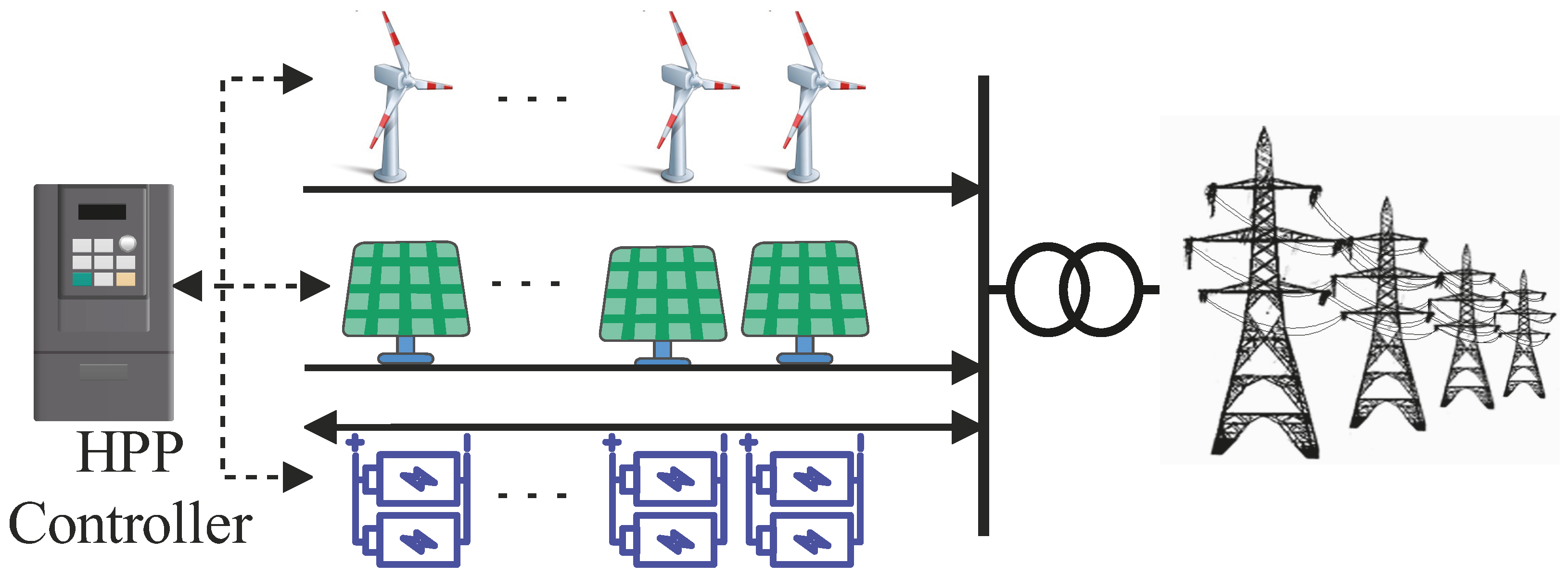
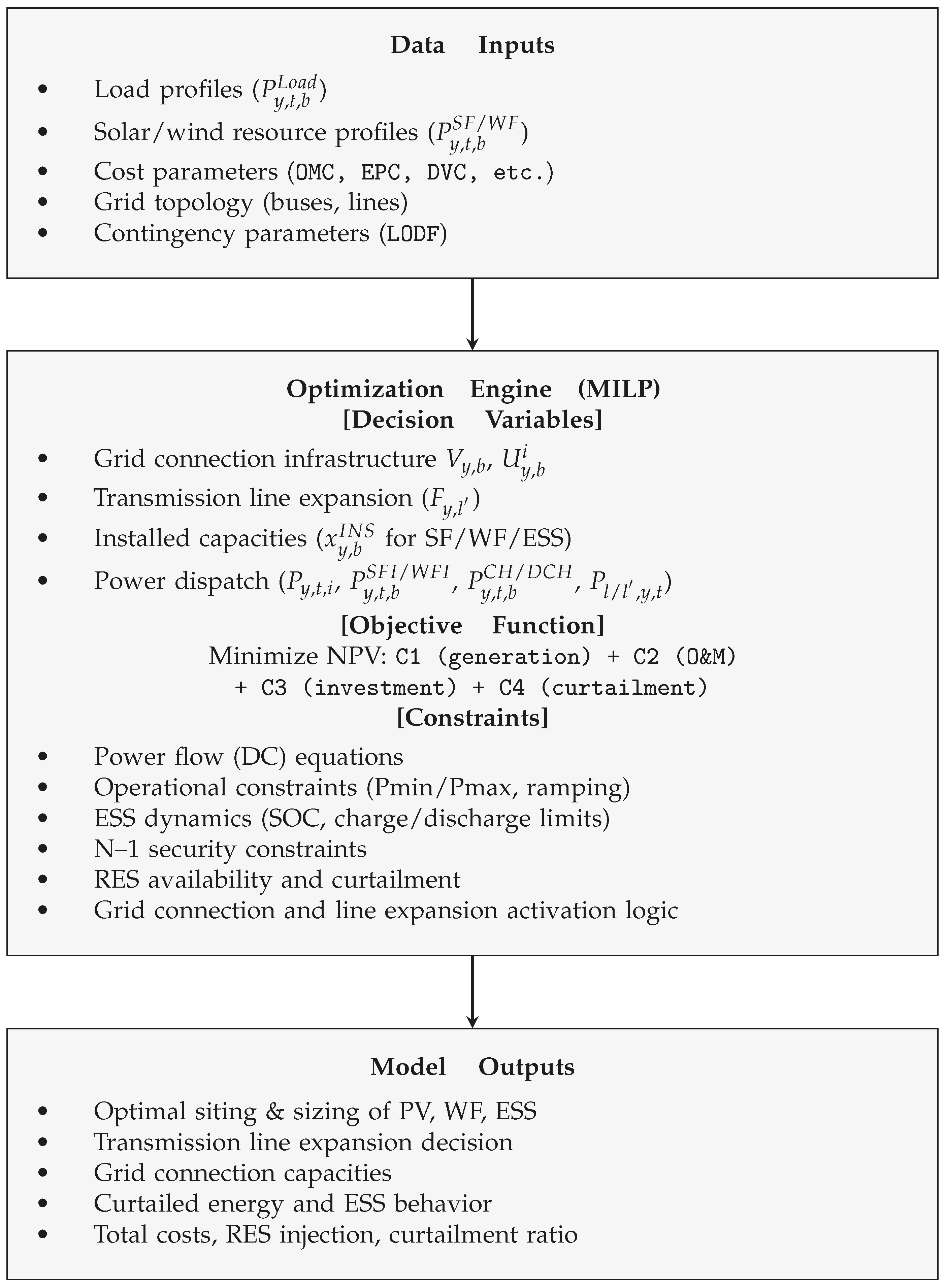
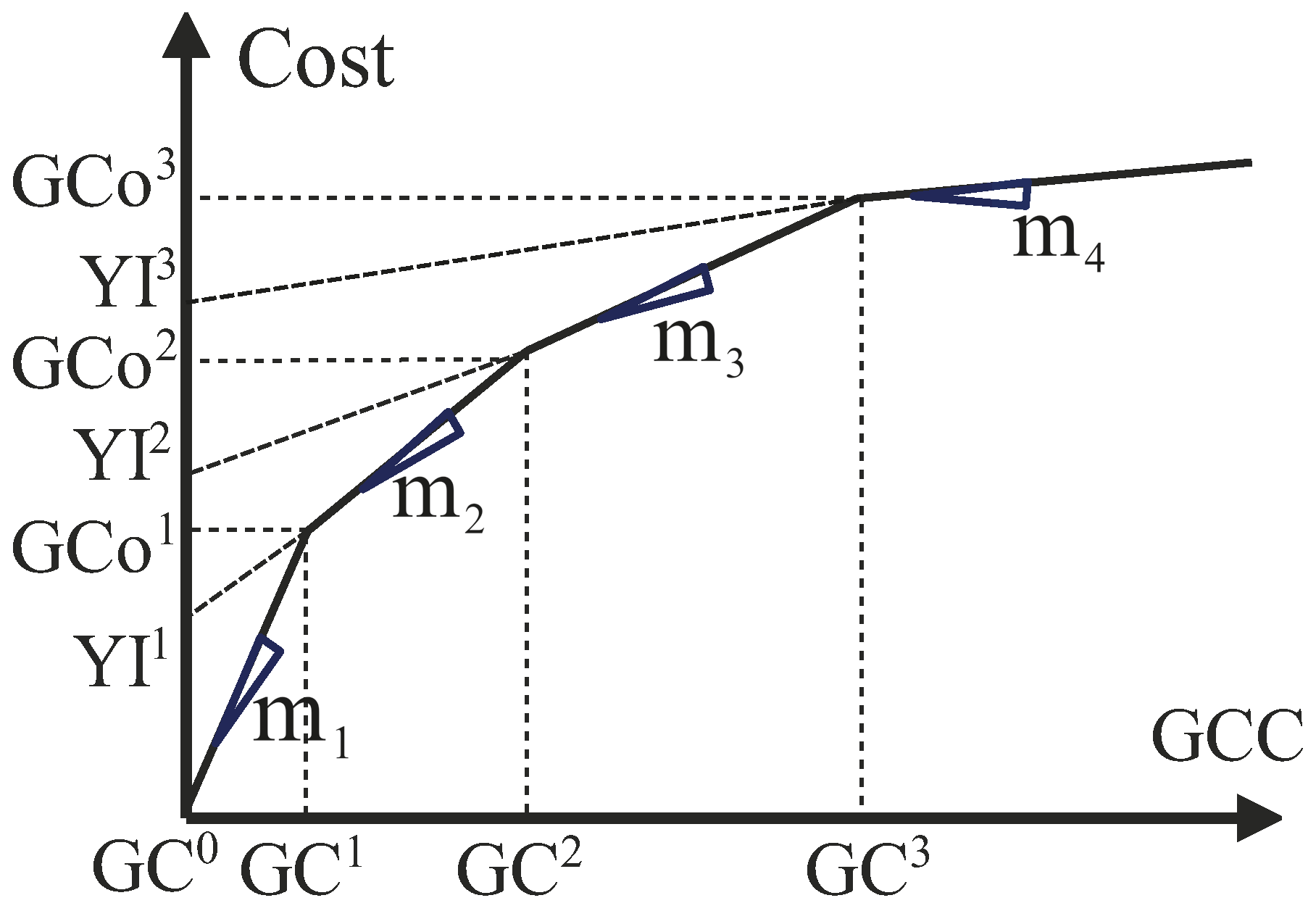
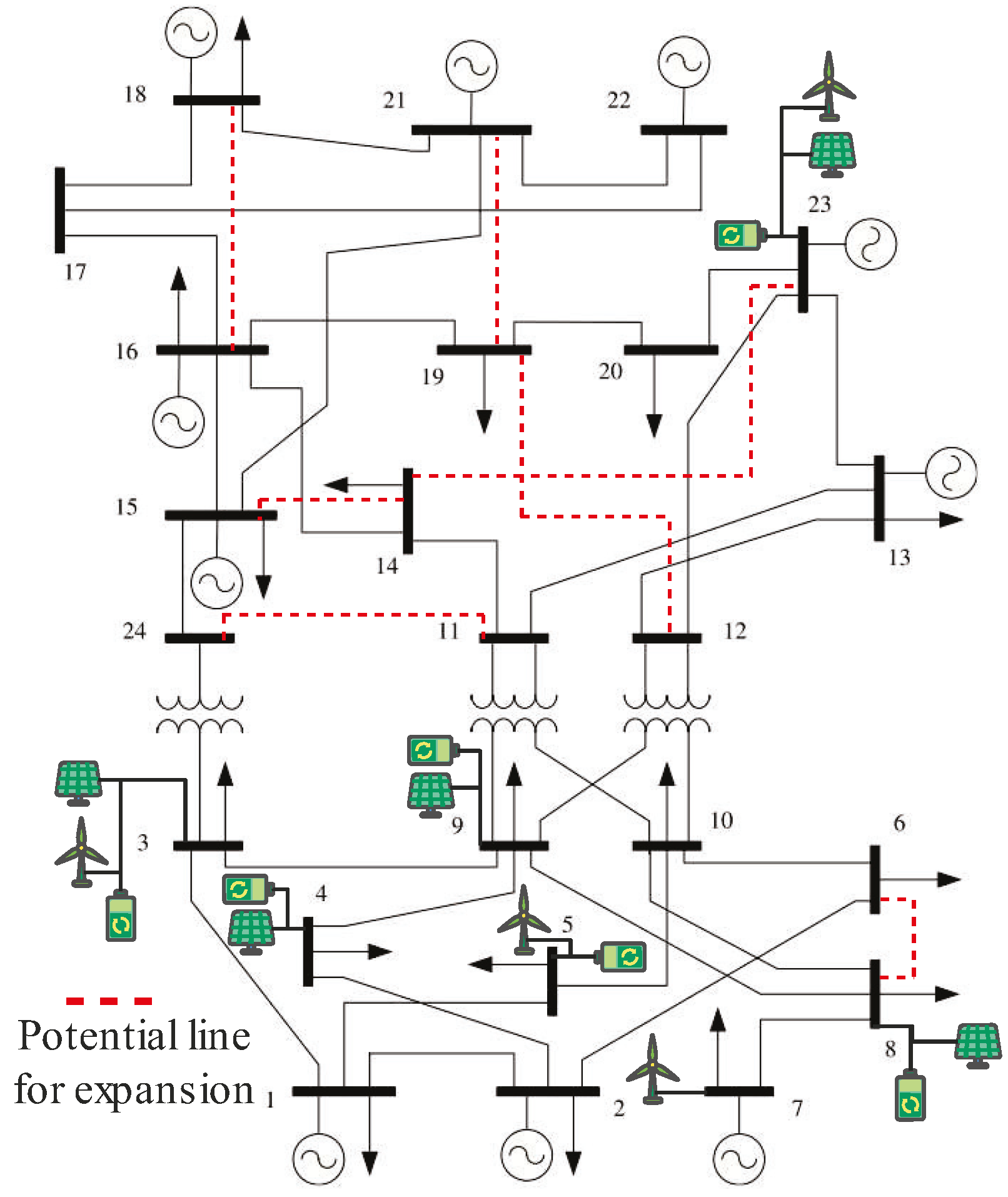
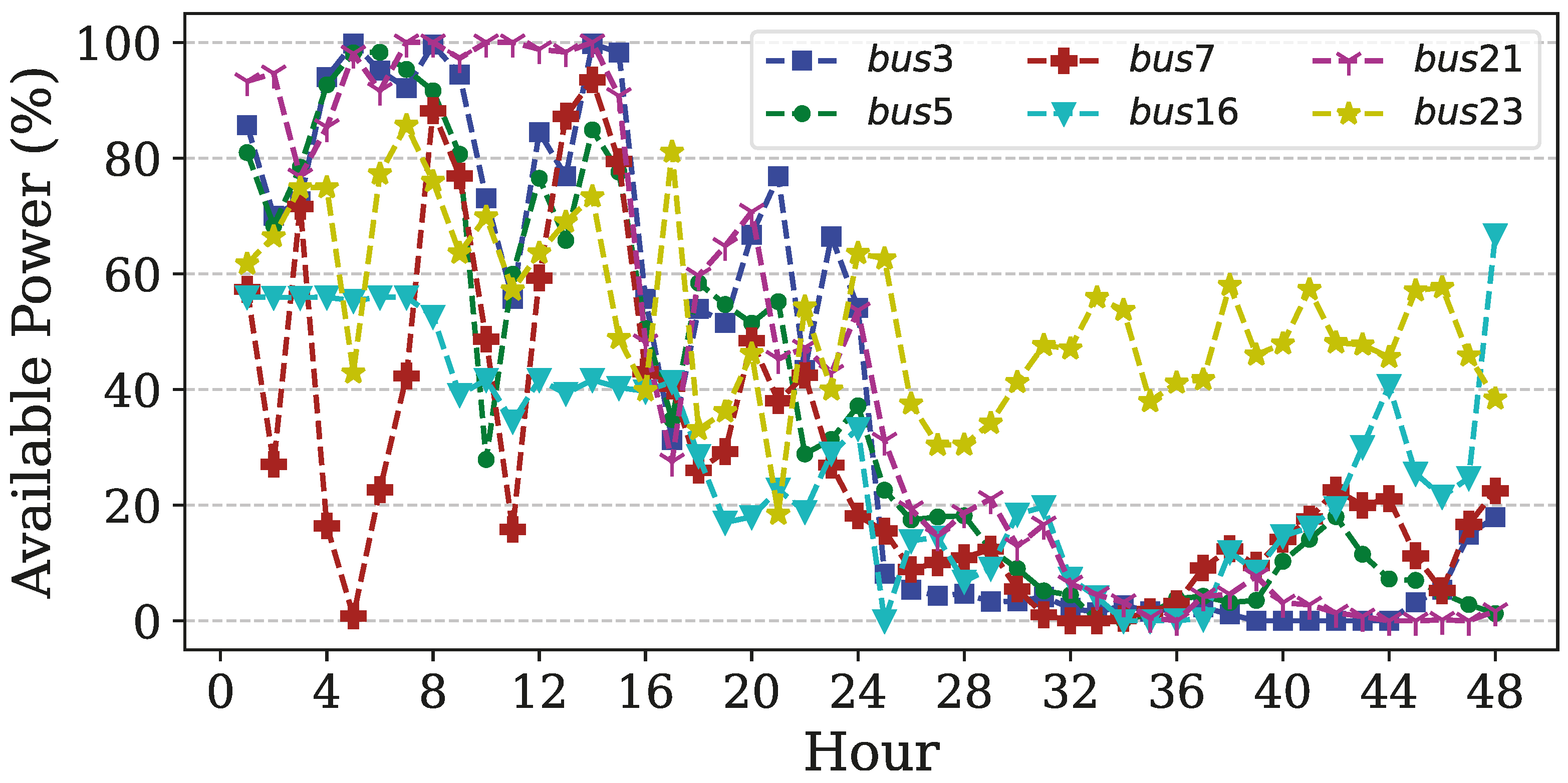
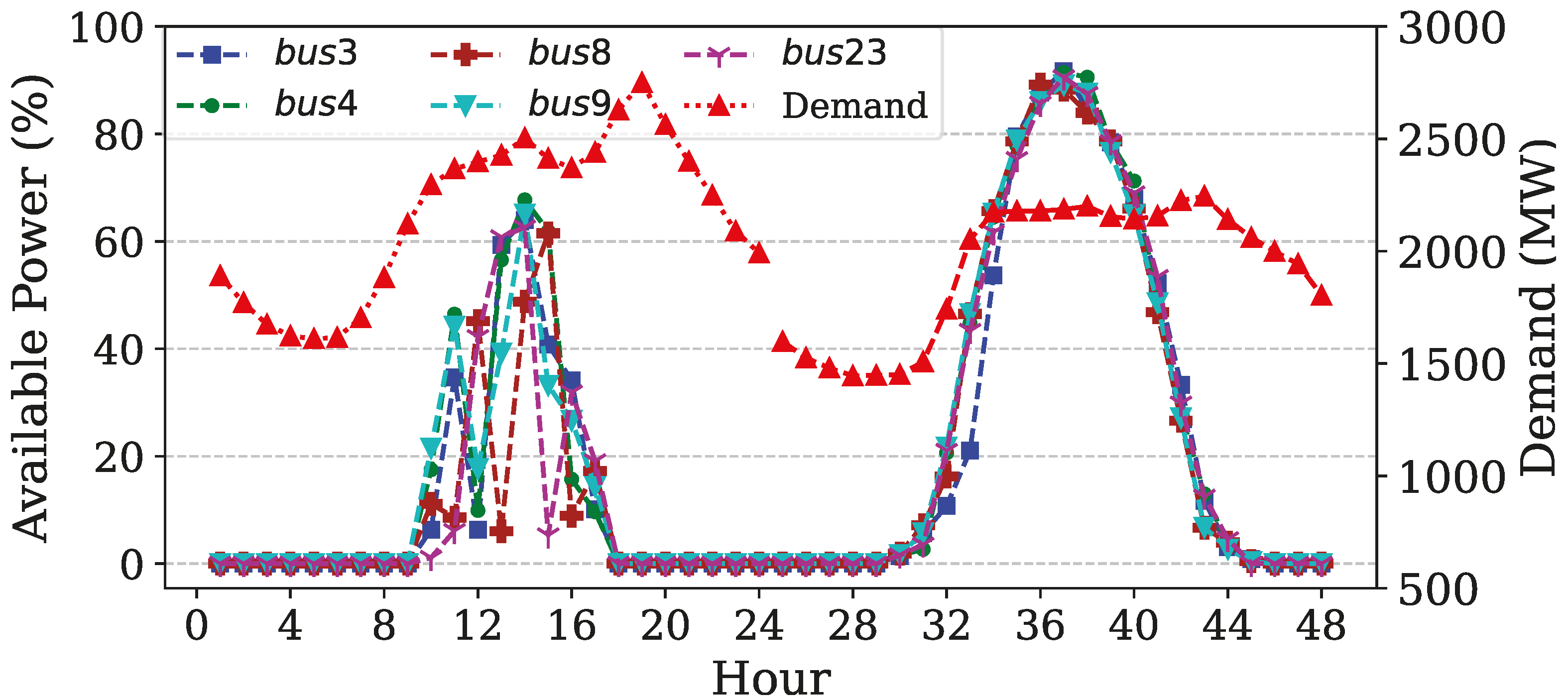
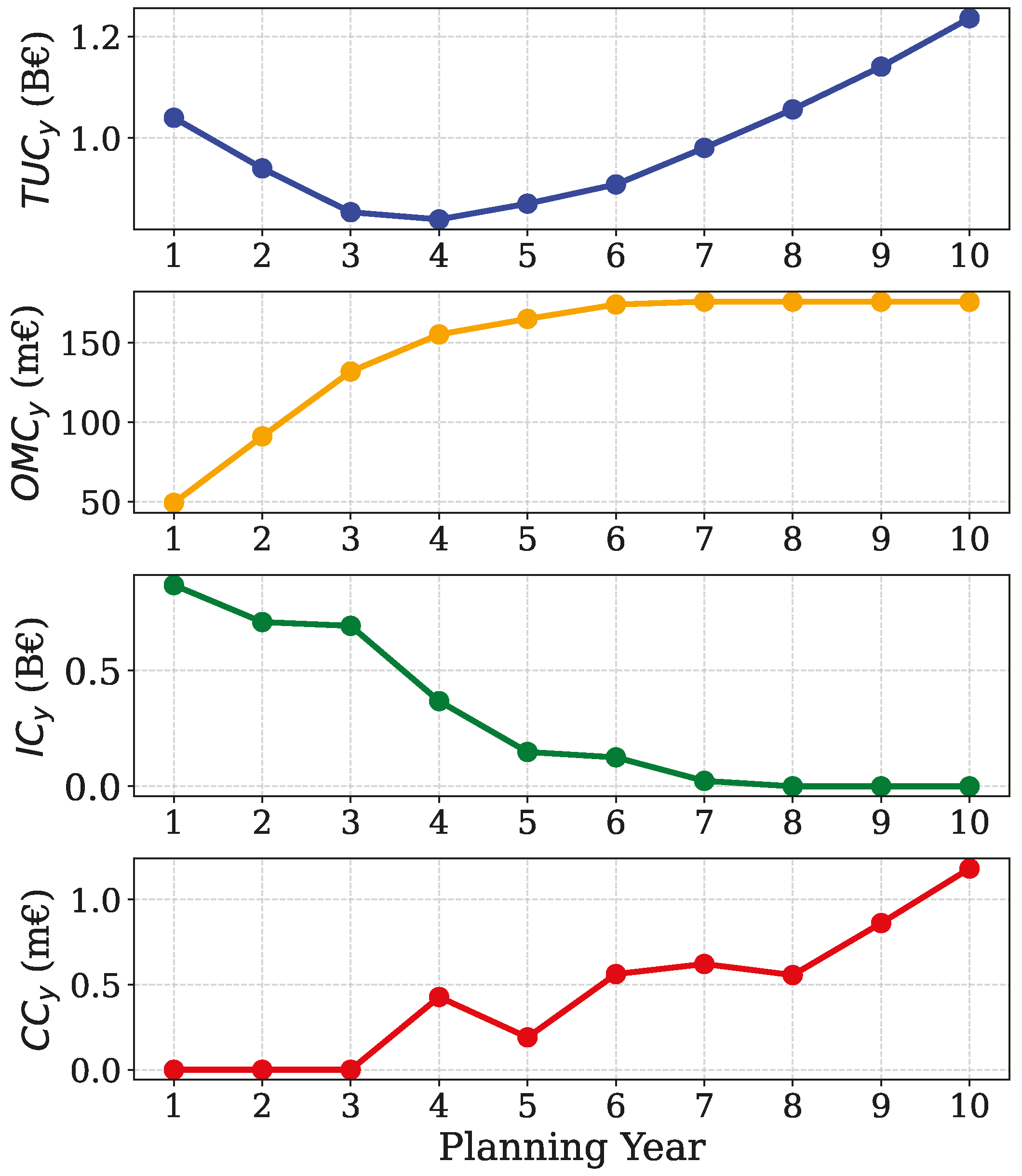
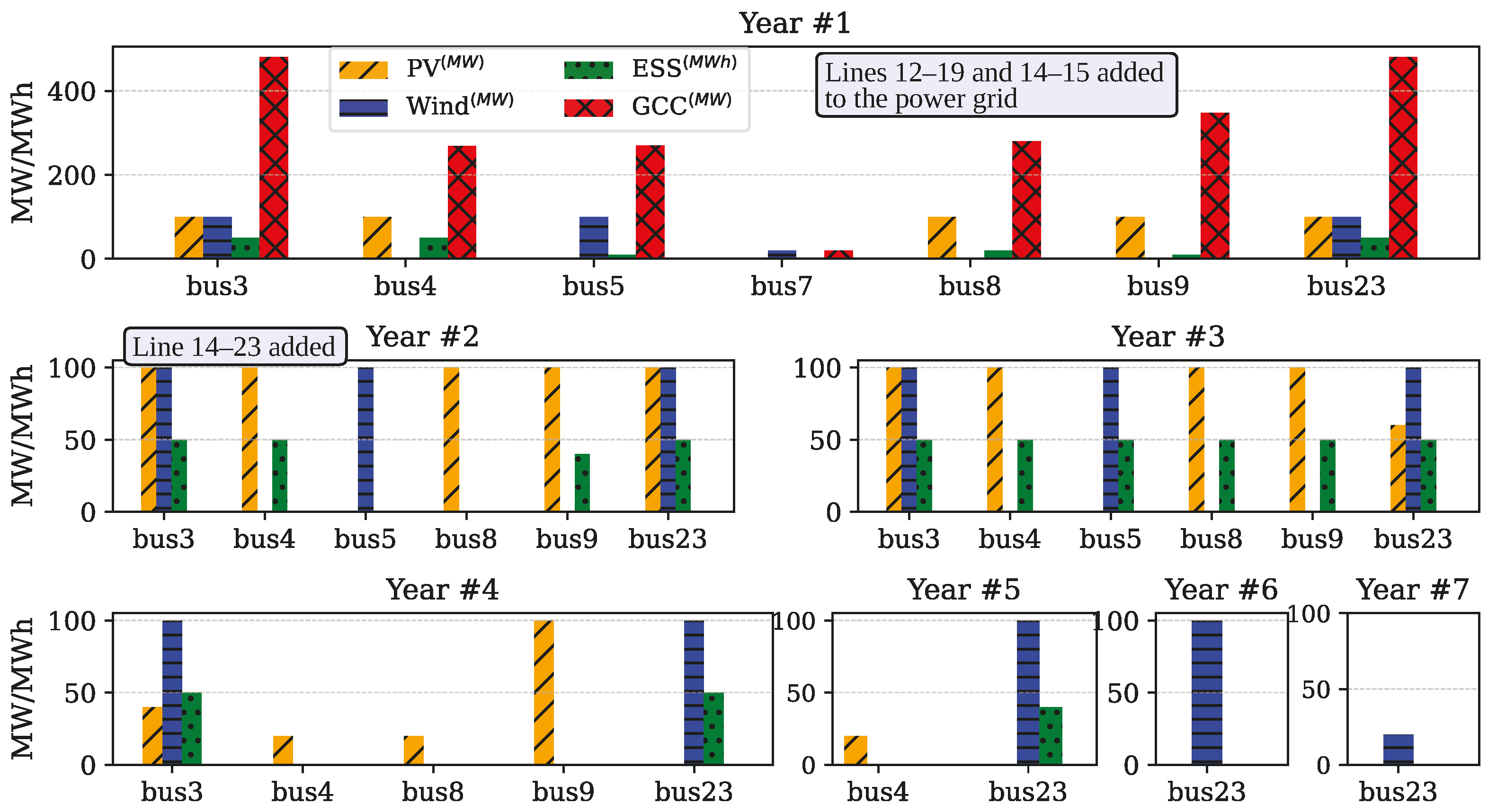
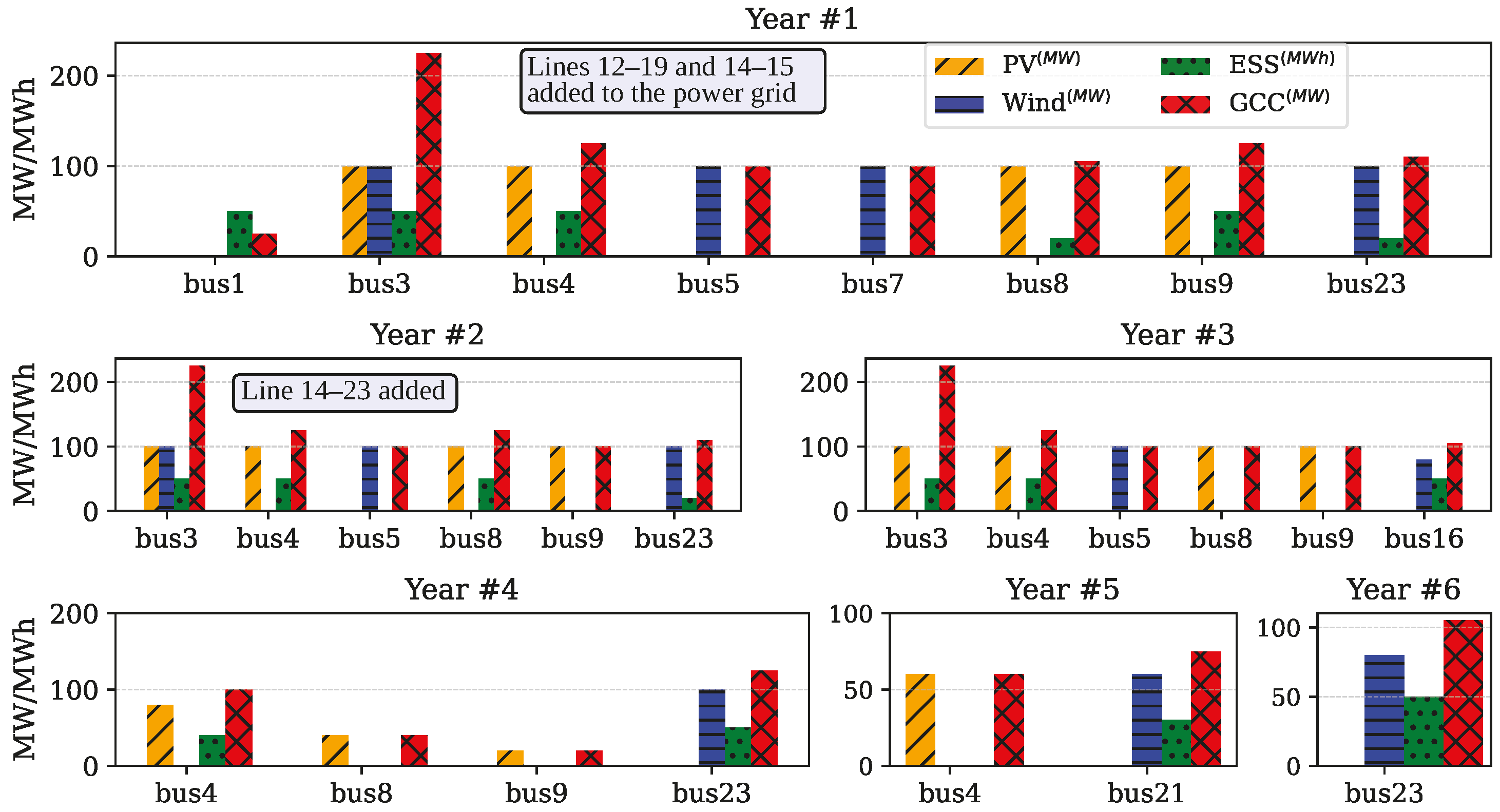
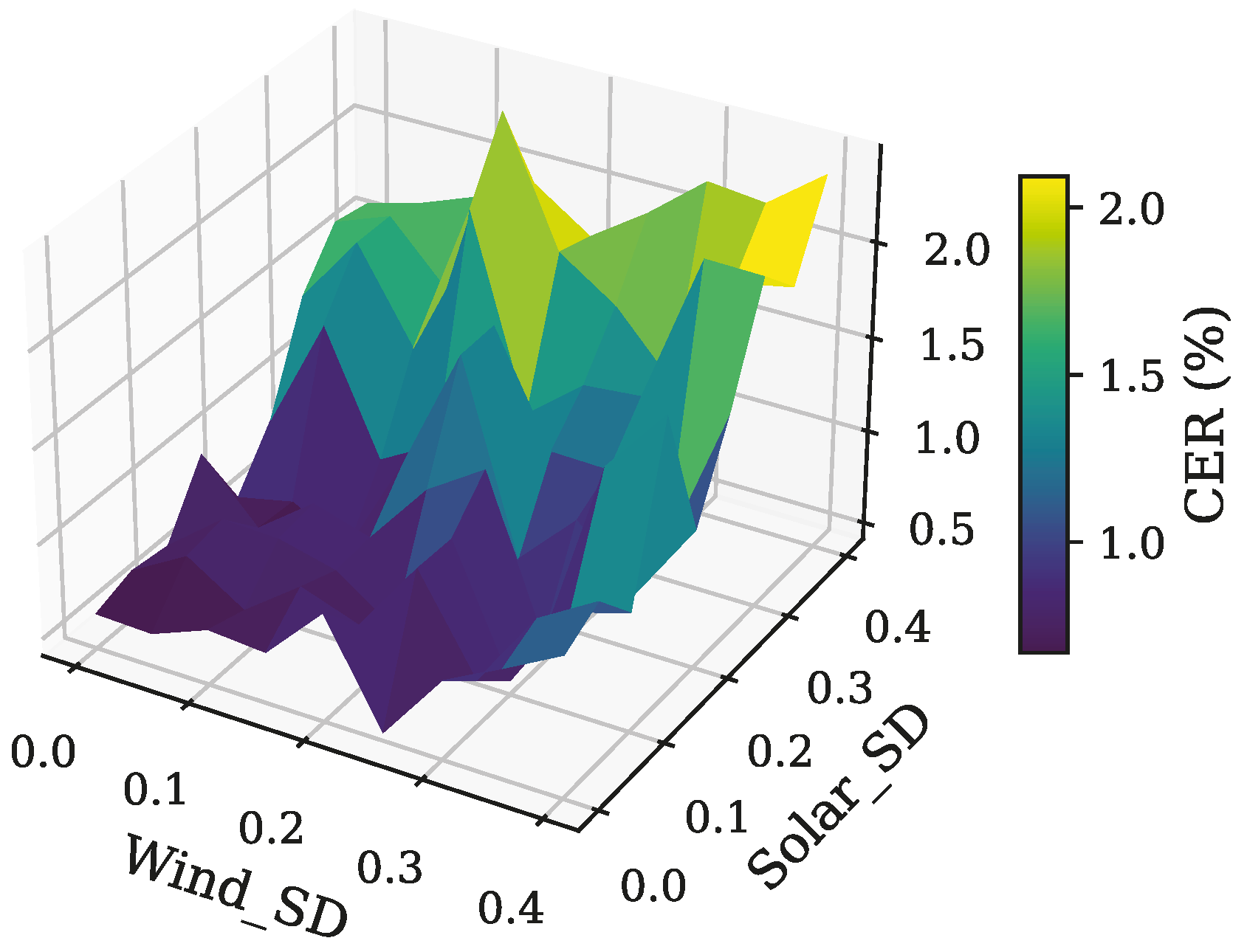
| Parameter (s) | Value (s) | Parameter (s) | Value (s) | |
|---|---|---|---|---|
| Finances | IR | 4% | [25] | |
| €2/MWh | €1/MWh | |||
| €2/MWh | €14.42 k/MW-y | |||
| €3 k/MW-y | €4.5 k/MW-y | |||
| €5 k/km-y | €3 k/km-y | |||
| €500/MW-y | €5.14 k/MW-y | |||
| €450 k/MW | €1.2 m/MW | |||
| €40 k/MWh | €40.70 k/MW | |||
| €30/MWh | €200 k/MWh | |||
| €60 k/MW | €300 k/km | |||
| €100 k/km | €2, 4.25, 6.75 m | |||
| €5, 17.5, 27.5k | – | |||
| Technicals | 90% | 5% | ||
| 10 MWh | 20 MW | |||
| [25] | [25] | |||
| 20, 50, 100 MW | [25] | |||
| 0.2 | 0.5 | |||
| €8.351B | €1.105B | €2.768B | €3.380m | €12.23B |
| €9.406B | €0.902B | €2.301B | €2.910m | €12.61B |
| Variable | HPP Model | Independent Model |
|---|---|---|
| €12.23B | €12.61B | |
| RESs allocation | 3000 (MW) | 2520 (MW) |
| ESSs allocation | 820 (MWh)/410 (MW) | 730 (MWh)/365 (MW) |
| Total | €103.69 m | €214.88 m |
| Calculation time | 580 s | 232 s |
| Iterations (nodes) | 28,510 | 9221 |
| Curtailment Cost (€/MWh) | Total RESs Allocation (MW) | Total ESSs Allocation (MWh) | CER (%) |
|---|---|---|---|
| 5 | 3140 | 760 | 1.29 |
| 15 | 3100 | 780 | 0.99 |
| 30 | 3000 | 820 | 0.22 |
| 50 | 2960 | 800 | 0.15 |
| 80 | 2980 | 830 | 0.06 |
| Variable | Security Constrained | Without Security Constraints |
|---|---|---|
| €12.23B | €11.49B | |
| RESs allocation | 3000 (MW) | 3040 (MW) |
| ESSs allocation | 820 (MWh)/410 (MW) | 760 (MWh)/380 (MW) |
| RESs injected energy | 67.46 (TWh) | 68.26 (TWh) |
| RESs curtailed energy | 148.8 (GWh) | 120.0 (GWh) |
| Base Case | Optimistic Case | Pessimistic Case | |
|---|---|---|---|
| Final planning year | 7 | 8 | 6 |
| Total RES capacity (MW) | 3000 | 3120 | 2940 |
| Total ESS capacity (MWh) | 820 | 870 | 780 |
| RES in 1st year (MW) | 820 | 780 | 820 |
| ESS in 1st year (MWh) | 180 | 150 | 200 |
| RES in final year (MW) | 20 | 80 | 80 |
| ESS in final year (MWh) | 0 | 30 | 0 |
Disclaimer/Publisher’s Note: The statements, opinions and data contained in all publications are solely those of the individual author(s) and contributor(s) and not of MDPI and/or the editor(s). MDPI and/or the editor(s) disclaim responsibility for any injury to people or property resulting from any ideas, methods, instructions or products referred to in the content. |
© 2025 by the authors. Licensee MDPI, Basel, Switzerland. This article is an open access article distributed under the terms and conditions of the Creative Commons Attribution (CC BY) license (https://creativecommons.org/licenses/by/4.0/).
Share and Cite
Taheri, M.; Rabiee, A.; Kamwa, I. Enhanced Renewable Energy Integration: A Comprehensive Framework for Grid Planning and Hybrid Power Plant Allocation. Energies 2025, 18, 4561. https://doi.org/10.3390/en18174561
Taheri M, Rabiee A, Kamwa I. Enhanced Renewable Energy Integration: A Comprehensive Framework for Grid Planning and Hybrid Power Plant Allocation. Energies. 2025; 18(17):4561. https://doi.org/10.3390/en18174561
Chicago/Turabian StyleTaheri, Mahmoud, Abbas Rabiee, and Innocent Kamwa. 2025. "Enhanced Renewable Energy Integration: A Comprehensive Framework for Grid Planning and Hybrid Power Plant Allocation" Energies 18, no. 17: 4561. https://doi.org/10.3390/en18174561
APA StyleTaheri, M., Rabiee, A., & Kamwa, I. (2025). Enhanced Renewable Energy Integration: A Comprehensive Framework for Grid Planning and Hybrid Power Plant Allocation. Energies, 18(17), 4561. https://doi.org/10.3390/en18174561







